Anytime you’re using snowshoes to put more than 200lbs/90kg atop unpacked snow—be it powder, wet, or crusted—you’re going to want to spread it out across as much space as is practical. A snowshoe’s surface area or the amount of space the snowshoe covers will help to distribute weight and limit post-holing (or punching holes into deep snow).
Thus, snowshoes with wider areas tend to be best for carrying big people and heavy loads. My informed opinion is that you should go with no smaller than a 10″ wide x 36″ long or 12″ wide x 30″ long pair of raquettes for the task. Some snowshoe brands will list their sizing as length only (i.e., 30, 36, etc.) Choosing the right size snowshoe will provide the best experience and depends on a few factors.
Thus, in this guide, we list several styles of snowshoes for big people and heavy loads and cover snowshoe sizing extensively.
Snowshoe Sizing
Modern Snowshoes
Traditional Wood Frame Snowshoes
Magnesium Military Snowshoes
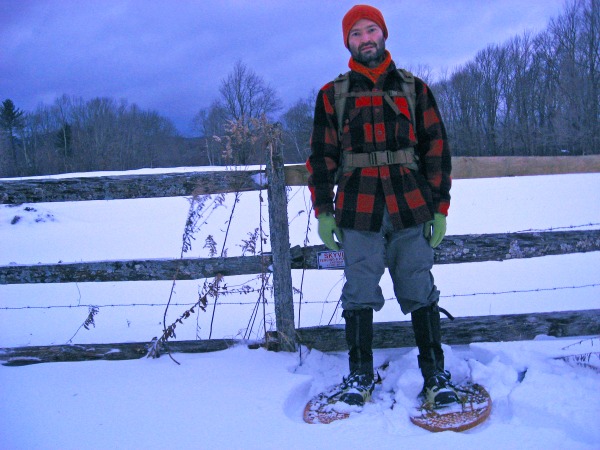
A large dimension pair of traditional snowshoes like these Hurons helps keep you from floundering in the powder with a big pack on your back. Photo: Matthew Timothy Bradley
Some of the links in this article may contain affiliate links. When you purchase using these links, part of the proceeds go to Snowshoe Mag. Additionally, as Amazon Associates, we earn from qualifying purchases. Please see our disclosure for more details.
Snowshoe Sizing for Heavy Loads
One of the most common factors used in snowshoe sizing is a person’s total weight, including any gear they’re carrying while hiking. You’ll notice that many of the snowshoes below come with a recommended weight range, which typically relates to the snowshoe’s ability to help you “float” on the snow.
However, Joanne Petrozzi and the team at Dion-NeviTREK Snowshoes mentioned, “The weight recommendations that we use are based on the industry standards but modified somewhat based on past experience and customer feedback…[However], weight does not always tell the whole story when choosing a snowshoe size.”
She states, “People should also consider snow conditions, maneuverability, and the type of trails and type of snowshoeing they expect to be doing when choosing the right snowshoes.” Let’s break down those factors a little more.
Snow Conditions
The conditions of the snow vary around the world and day to day. For example, “The northeast U.S. typically experiences snowfall that is heavy and wet while the higher elevations in the western U.S. and Europe get powder. Also, snow conditions change from day to day from the same snowfall. Even powder, after a day or so, will be packed a little,” says the Dion-NeviTREK team.
What does this mean for choosing large snowshoes? First, your snowshoes will naturally not sink as far in wet snow or packed snow compared to deep or dry, fluffy powder snow. “The important thing to a snowshoer is to have snowshoes that fit them properly and allows them to walk around in deep snow,” states Dion-NeviTREK
Thus, if you live in an area where the snow tends to be heavy and wet, you can most likely use a smaller size snowshoe, even if you and your gear don’t fall within the weight recommendations. Similarly, if snowshoeing on packed trails, you can use a snowshoe with a lower weight recommendation since you won’t be sinking.
Read More: Snowshoeing in the Midwest (A Little Different Than East or West)
Maneuverability
Each snowshoe outing is unique, and what you make of it. Sizing can affect how easily you can move around on your chosen terrain, and the team at Dion-NeviTREK offers their recommendations.
“Too large of a snowshoe with too little traction acts like a snowboard. On some trails, traction/grip is more important than floatation. [For example], on steep climbs, it might be better to use a shorter snowshoe for traction. A longer snowshoe may make it difficult to lift your foot over downed trees or other obstacles that you might find on a wooded trail.”
So, in this case, if you regularly climb steep terrain, find the shortest snowshoe that can support your weight. Like wet conditions, a shorter design will prove easier to climb and descend on steep hills. In general, the team at Dion-NeviTREK recommends that you’ll want to avoid getting too large a snowshoe. Instead, make sure to can walk normally. Try to get the smallest snowshoe you can get away with without post-holing.
Read More: Why To Use Snowshoes While Mountaineering
Boot Size
When choosing snowshoes for big people and heavy loads, it’s helpful to consider the snowshoe binding. However, it can be tough to choose a binding with so many variations and designs.
Simple two or three-strap bindings, including the A and H strap bindings on many traditional snowshoes, tend to be the best bet for an easy fit with less maintenance. Dion-NeviTREK also notes that “The bindings should fit snugly over a person’s boot, [and] be easy to put on and tightened in cold weather, possibly with gloves.”
Most bindings tend to fit feet up to a men’s size 14 (15.5 women, 13.5 UK). “If you wear a snow boot larger than a size 14, you should check to make sure the straps are long enough on the binding,” suggests the team at Dion-NeviTREK. Some manufacturers will include shoe size recommendations. However, if you have a foot larger than a U.S. men’s 14, check with the manufacturer to see if they offer longer straps.
Read More: The Systems That Bind: An Overview of Snowshoe Bindings
Snowshoe Options for Heavy Loads
Now that you know how to size your snowshoe, here are three types of snowshoes to consider for your adventure.
Option 1: Modern Snowshoes
You can use modern snowshoes made of aluminum or other materials for carrying heavy loads. Wide models greater than 12″ and lenticular (lens-shaped) or teardrop-shaped tend to have the most expansive surface area. Thus, they have the greatest chance of supporting heavy loads.
I am a big fan of wide snowshoes for flat and rolling terrain. But, as far as I know, only one company manufactures metal frame/synthetic decking models in widths of 12″ or greater, GV Snowshoes. In fact, the GV Wide Trail is excellent in deep snow conditions. Regarding lenticular snowshoes, I have found these tend to be better for steep terrain, and many people prefer them for all-around use.
Modern Snowshoe Examples
Here are a few examples of modern snowshoes that can accommodate big people and heavy loads.
Dion/NeviTREK
Adirondack Series 30, 36 (up to 240 lbs/109 kg and up to 275 lbs/125 kg)
Tracker Series 30 (up to 240 lbs/109 kg)
Faber
Mountain Quest 9 x 30, 10 x 36, 13 x 30, 11 x 40 (supporting 250 lbs/113 kg to 350 lbs/159 kg)
North Hiker 9 x 29, 10 x 34 (supporting 225 lbs/102 kg to 275 lbs/125 kg)
Mountain Expert 8 x 28, 9 x 30, 10 x 36 (supporting 200/90kg to 300 lbs/136 kg)
MSR
Lightning Ascent technical 8 x 25, 8 x 30 (supporting 220 lbs/100 kg to 280 lbs/127 kg)
Option: You can also purchase a tail extender for Lightning snowshoes, which attaches to the snowshoe to provide extra length for better floatation in deep snow. The tail extenders can bring the weight support up to 280-300 lbs (136 kg).
Redfeather
Hike 30, 36 (up to 220 lbs/100 kg and over 225 lbs/102 kg)
Alpine 30, 35 (up to 220 lbs/100 kg and over 220lbs/100 kg)
Tubbs
Wilderness 25, 30, 36 (supporting 200/90kg to 300 lbs/136 kg)
Panoramic 25, 30, 36 (supporting 200/90kg to 300 lbs/136 kg)
Mountaineer 25, 30, 36 (supporting 200/90kg to 300 lbs/136 kg)
Read More: Definitive Guide: How to Choose Snowshoes for Your Needs
Option 2: Traditional Wood Frame Snowshoes
Traditional snowshoes come in various conventional shapes and designs, each specialized for a particular environmental niche. They are great snowshoes for big people and heavy loads because they have a larger surface area. I think traditional snowshoes provide more floatation per square inch than metal and synthetic models, but that is admittedly up for debate.
However, two things are beyond debate when comparing traditional and metal and synthetic models.
- Traditional snowshoes are quieter. So, apart from the aesthetic experience, this makes them an excellent choice for hunters and wildlife photographers, as long as the snow does not have a frozen, crusty layer on top.
- You can’t just ride them hard and put them up wet. You can ride ’em hard, but you need to put ’em up dry and airy to ensure long life.
Traditional Snowshoe Examples
Here are a few examples of traditional snowshoes that can accommodate big people and heavy loads. You may also be able to find used wooden snowshoes that only need a new binding. Some manufacturers, like Dion-NeviTrek, offer modern bindings that can be used on wooden snowshoes.
Country Ways
Alaskan 10 x 56 and 12 x 60 (up to 260 lbs/118 kg and up to 300 lbs/136 kg)
Huron 12 x 42 (up to 220 lbs/100 kg)
Objiwa 10 x 48, 11 x 54 and 12 x 60 (up to 240 lbs/ 109 kg and over 210 lbs/95 kg)
Iverson
Ojibwa 11 x 56 and 12 x 60 (up to 250 lbs/113 kg and up to 300 lbs/136+ kg)
Michigan 12 x 46 and 13 x 46 (up to 240 lbs/ 109 kg and up to 250 lbs/113 kg)
Maine Guide Snowshoes
Alaskan 12 x 60 (up to 300+ lbs/136+ kg)
Sportsman 11 x 42 (up to 250 lbs/113 kg)
Read More: A Few U.S Artisans Keep Traditional Snowshoes a Tradition
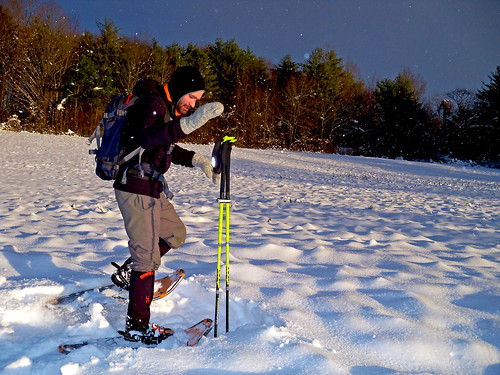
The author is breaking trail with 10″ x 36″ Faber Mountain Master snowshoes. Lenticular snowshoes are less awkward in steep terrain and preferred by many for general use. Photo: Matthew Timothy Bradley
Option 3: Magnesium Military Snowshoes
As an alternative to traditional and modern models, military snowshoes are another option for big people and heavy loads. Magnesium frame, stainless steel webbing military surplus snowshoes are widely available online and in Army-Navy stores.
These snowshoes combine the dimensions of a traditional Huron snowshoe with the durability of metal components. They also take advantage of the switch from wood to magnesium to add some frame-based traction in the form of some small teeth to provide a little grip for icy patches and light climbing.
I have yet to have the opportunity to try a pair of these out, but they have a generally good reputation, except for two caveats:
1. This model has a reputation for poor performance in wet snow. I imagine that globs of snow clump atop the decking and that both the frame and the webbing are subject to snowballs. Though, you may be able to limit snowballs by coating your crampons with a lubricant, such as WD-40 or the more environmentally friendly Nexus Green Marine Lubricant.
2. If you purchase a pair of these, they may come with a set of nylon military-issue bindings thrown in at no additional charge. These I have used, and there is a reason they would be thrown in for free: they are absolute garbage. Thus, do yourself the favor of purchasing a set of commercial off-the-shelf bindings designed for traditional snowshoes sooner rather than later.
Overall
There are three types of snowshoe designs for big people and heavy loads: modern snowshoes, traditional snowshoes, and magnesium military snowshoes. Each type has a variety of styles to choose from for your outing.
However, the sizing of your snowshoes is crucial. If snowshoeing in packed snow conditions or in wet snow, you won’t be sinking as deeply and, therefore, can choose a smaller size that fits your foot. To ensure you have the correct size, the team at Dion-NeviTREK recommends trying your snowshoes out with demo models. If not available, check the company’s return policy so you can return them if they don’t fit.
Now, let’s get out on the snow!
What other recommendations do you have? Also, are there snowshoes that you regularly use to carry heavy loads? Please share your thoughts with us in the comments below.
This article was originally published on Dec 8, 2014. It was most recently updated on Sept 29, 2022, and re-published on October 11, 2022.
Read Next: Snowshoeing for Beginners: The First-Timer’s Guide

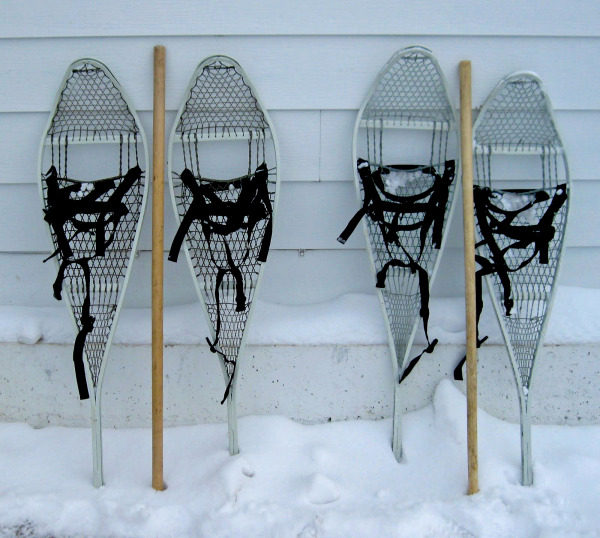
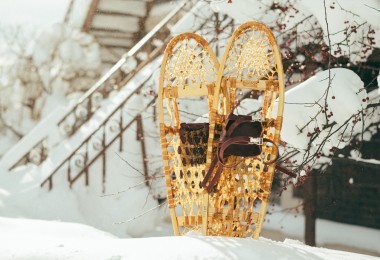
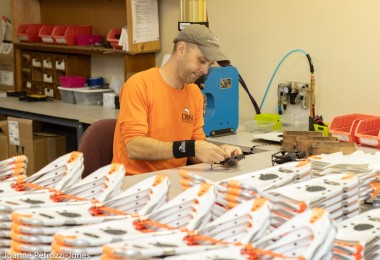
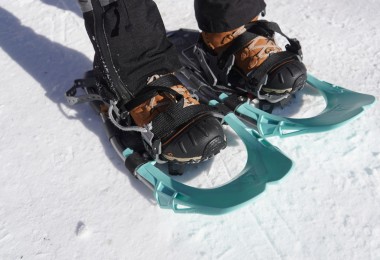
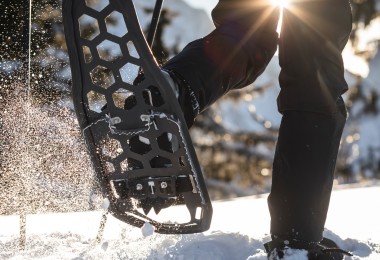

In relation to your snowshoe sizes i have a vintage pair of huron type that are 12″×60″ and have it stamped in black ink on the rail of one shoe only..i am in australia and have no info on them other than they were from canada. There is the remnant of a makers name on one that has ED and the back piece of a larger letter is visible. Any idea of the value pf these shoes..
Hi Steve, Thanks for your inquiry! Is the rail that has the black lettering on the toe bar? The toe bar is the piece that spans horizontally across the snowshoe near the top where your toes would lay. Browning snowshoes, which were located in Canada and who created snowshoes from the 40s- 60s, made several 12″x 60″ models and usually have the words “Made in Canada” on the toe bar. From what I’ve read, models that were made before the 50s tend to have more substantial increases in value. Depending on the specifics of your model, I’ve read of the values being anywhere between $200-$700. It may be worth taking the snowshoes to an antique dealer in your area to examine your snowshoe for other insights and see what they could be worth. I’d love to hear any other info that you find! -Susan, SSM Editor
Hi susan thanks for your reply..the 12× 60 is on the rhs rail right next to the toe bar and the remnants of a makers name are on the toe bar that was a black oval shape sticker with a thin gold outer line around it with smaller gold lettering starting with ED and curving across the top of the sticker..and what looks like he beginnings of an H in larger font in orange..maybe for HURON..sticker was 2 .1/4″ across and about 1″ high…
Hi Steve, I apologize for the delay in my reply! I have been doing some additional research, but most of the companies I’m familiar with have the maker listed on the toe bar. I do know Torpedo snowshoes were also manufactured in eastern Canada and typically list the snowshoe size/type in black lettering on the ‘shoe. The ‘ed’ struck me there, but you mentioned that it’s at the beginning of the word and on the right-hand rail, so it might not be a match. In addition to the large corporations, many individuals made their own snowshoes and branded them around that time. It could be possible that it’s an independent snowshoe manufacturer without much history. Any luck on having an antique dealer looking more closely at the snowshoe? I’ll keep looking for info, and I wish I had more information for you! -Susan, SSM Editor
Thank you for the article! Looking to get my brother into snowshoeing to get him off the couch. He’s 6’3 about 380lbs. Matthew any suggestions for a Mens size 15/16 shoe? Would also appreciate a recommendation for myself 5’2 about 210lbs. (I’m a skier downhill and xc but haven’t snowshoed in a few years). Thanks in advance for any assistance!
Hi Jan, Thanks for reaching out! Your best bet for a binding that will fit a size 15/16 men’s shoe/boot are snowshoes that have simple strap bindings, such as the Posilock or DuoFit bindings from MSR (here’s a helpful article for MSR about these bindings). You’ll want to ideally avoid bindings that have a box for your toes since those can be more difficult to fit larger boot sizes. If the simple strap bindings are still too small, many companies will sell extra-long strap bindings. For example, MSR sells 18-inch binding straps for larger boot sizes.
As far as specific snowshoe sizes, it really depends on the type of snow on your snowshoe outings. The weight recommendations listed for snowshoes are typically weight recommendations if you’re snowshoeing on powder (you’ll have to check the manufacturer guidelines). The recommendations are given to limit your sinking in the snow. If though, you are snowshoeing on wet snow or shallow snow where you’re less likely to post-hole (sink), then there is more flexibility in these weight recommendations and you most likely can use the snowshoe even if over the weight guidelines. Faber and GV Snowshoes, both Canadian snowshoe manufacturers, make some of the largest snowshoe sizes and could be a great place to start for your brother. The Mountain Quest is offered in size 11 x 40, which has a recommendation of 350 lbs.
When choosing your snowshoes, though, it can be easy to focus on weight recommendations, but you’ll also want to pay attention to the fit on your foot. Sometimes folks will choose snowshoes that are way too long because they’re looking solely at weight recommendations. MSR makes snowshoe tails for their snowshoes, which can be attached to the end of your snowshoe. So for your own snowshoes (again it depends on the snow conditions), but if snowshoeing on wet snow, the Revo snowshoe line by MSR could be an option. Then, you could always add on the tails if you need more support and flotation in light powder.
I hope this is a helpful starting point! If you have any other questions, you can always email me anytime at susan[at]snowshoemag.com. 🙂 – Susan, Snowshoe Mag Editor
Do any manufacturers make a snowshoe yo fit a men’s size 16 boot?
Thanks for reaching out! The largest size I’ve seen is for M 15. However, snowshoes with simple strap bindings that allow for more maneuverability will be the best bet to accommodate larger boot sizes. These types of bindings, such as the Duofit and Posilock bindings from MSR, can accommodate snowboard boots quite well. I would recommend avoiding bindings with limitations (such as a toe box) since these can be more difficult to fit larger boots. Many manufacturers will list the shoe sizes for their bindings, and some companies (such as MSR) sell extra-long straps for larger boot sizes. I hope this helps! If you have any other questions, please feel free to email me anytime at susan[at]snowshoemag.com.
Louis Garneau makes several models in 10×36 size, for everything from trail walking to backcountry exploring. I have a pair of their Blizzard II backcountry ‘shoes and can’t say enough good stuff about them. They’re just excellent, excellent snowshoes, and I find they have better flotation than 10×36 Tubbs because they have a less tapered, more rounded frame.
Thanks, Phil! I’ve added Louis Garneau to the snowshoes we have listed here. It looks like they don’t have the Blizzard II in 10×36 anymore (at least on their site), but they do have the Blizzard III. I haven’t tried any Louis Garneau shoes before, but I think I need to add them to my list 🙂
Have you heard of these snowshoes? I’m curious to know how they stack up against the ones you list for heavier loads. https://shop.fimbulvetr.no/products/fimbulvetr-tankr?variant=14037807300692
I want to get my boyfriend a pair of snowshoes so he can join me on my weekend outings. He’s 6’7″ and a little over 400lbs. His sport is powerlifting…
We live in Portland so snow can be wet. In my research, it looks like the military issue shoes are the best bet, but do you have any other relatively affordable suggestions for that giant of a load?
Nothing affordable off the top of my head, no. I prefer traditional snowshoes with widely-spaced, full hide lacing for wet snow. The Green Mountain style would be the way to go if there is any climbing to be done.*
Spraying PAM on metal frame snowshoes does make a difference in wet snow. If you give that a try and have indoor pets, do remember to hang them out of reach afterwards!
* https://www.snowshoemag.com/2012/11/25/the-morphology-of-snowshoes/
Megan, Did the recommendations work out for your boyfriend?
I have a new pair of the military surplus magnesium snowshoes. I have never snowshoed before but I am enrolled in a beginners course to happen soon. I cannot find COT bindings using google – can you provide information / link? Thanks. Earl
Earl,
Thanks for the question. Giving it some quick thought, I realize that maybe I should do an entire post on the topic! But I can give you a quick answer so long as you don’t mind that it will be less than comprehensive!
Would you say that the terrain you are planning to snowshoe across is more flat to rolling, or does it start to get a little more hilly to steep? And are you planning to go off trail and into the bush very much?